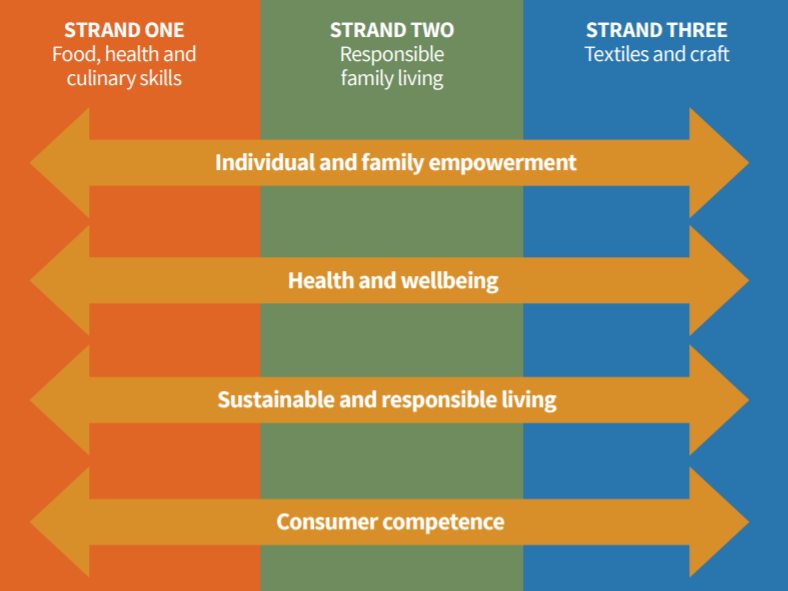Introduction to the Home Economics Course
.
Home Economics enables students to develop essential “life skills” and personal independence through adaptability, creativity and problem-solving.
Junior Cycle Home Economics develops the knowledge, understanding, skills and values necessary to achieve optimal, healthy and sustainable living for every person as an individual, and as a member of families and society. It is a subject which amalgamates theoretical and practical elements that can be taken at JC level through the traditional Junior Cycle. All first-year students sample Home Economics as part of a taster module. They then decide whether they would like to do Home Economics for the Junior Cycle. The specifications for the course span over three years and use an interdisciplinary approach integrated across three interconnected strands.
- Strand One: focuses on developing students’ food literacy, and culinary skills including menu planning, cooking, health and safety food skills, shopping, food waste, reading food labels and sensory analysis.
- Strand Two enables students to explore, from a systems perspective, responsible family living. Students develop an understanding of the different forms and role of families as the core social unit. Students develop life skills to enable them to manage resources responsibly and sustainably in the home, family and community.
- Strand Three focuses on developing students’ textile skills, knowledge and creativity. Practical textile and craft skills are integral to this strand and include hand and machine sewing skills, and fabric texturing and embellishment techniques. Students are enabled to make sustainable decisions as consumers in the choice and maintenance of clothing and textiles. Students will apply the design brief process in designing and making a textile item for an individual or the home.
Assessment is comprised of
formative (ongoing) assessment as well as summative assessment:
Formative:
- CBA One: Creative textiles- This is a project which is undertaken in second year and takes eight to ten weeks to complete. In ETSSW we focus on sustainable textile usage and upcycling. Students use the design brief process and create upcycled cushions which are embellished along with a textile portfolio.
- CBA Two: Food Literacy Skills brief- This is a project undertaken in third year it is based on briefs given by the State Examinations Commission which vary every year. Students have two to three weeks to complete CBA Two. CBA Two is related to the preparation for the practical food skills examination in April of third year.
- CBAs are assessed by the Home Economics teacher.
Summative assessment:
The final examination will consist of a practical food skills examination and a written examination. The practical examination and the written examination will each be allocated fifty per cent of the marks available.
A) Practical food skills examination:
Based on feedback, students reflect upon their preparatory work carried out as part of CBA Two and the direction they will take it in for the practical food skills examination. For the practical food skills examination, students are required to demonstrate the application of nutritional knowledge and practical culinary skills in the execution of one of the briefs issued by the State Examinations Commission. The practical food skills examination will be one hour and thirty minutes in duration with an additional thirty minutes of preparation time prior to the commencement of the timed examination. It is an individual examination completed at the end of third year.
Based on their chosen brief from CBA Two, students will demonstrate their culinary and creative food literacy skills by preparing, serving and evaluating healthy nutritious dishes or product/s to meet the requirements of the brief.
B) Written examination
Students will sit a written examination of one and a half hour’s duration. The written examination will take place at the end of third year. The final examination will be set and marked by the State Examinations Commission.
JUNIOR CYCLE HOME ECONOMICS SPECIFICATION

 A New Approach to Education
A New Approach to Education